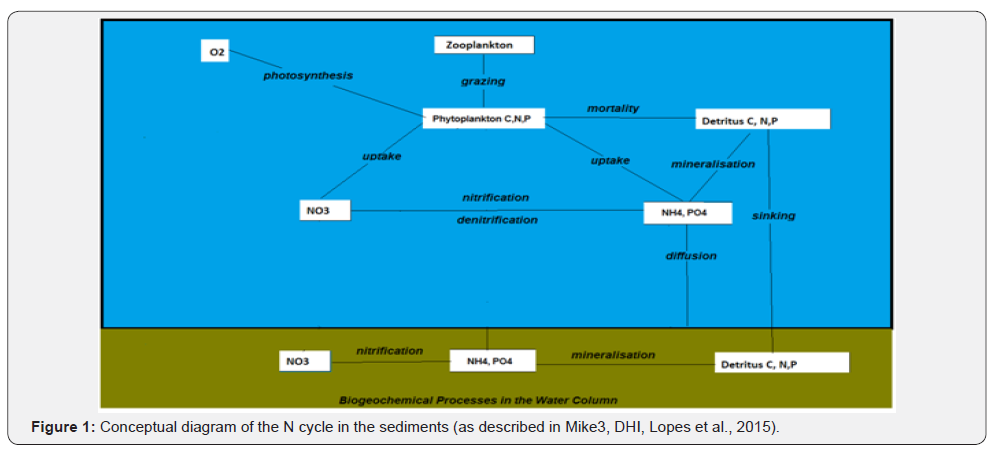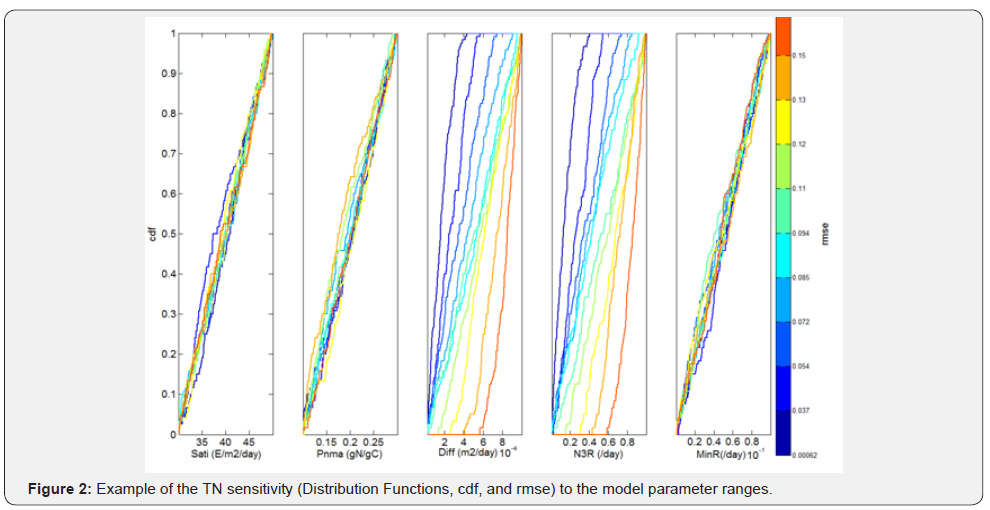Towards A Better Integration of the Sediment Biogeochemistry in the Modelling of the Coastal Systems- Juniper Publishers
Juniper Publishers- Journal of Oceanography
Abstract
Ecological models have been signficantly improved during the last decades, leading to more realistic predictions of coastal water processes under different forcing. Even though benthic sediments play an important role in biogeochemical processes occurring in the water column, in the past, very few modelling studies have taken into account these contributions. Recent efforts are being put into the implementation of coupled models, including the biogeochemistry processes occurring at both the upper benthic layer and the water column. This step is important, as along with the river supply, benthic nutrient regeneration can contribute significantly to the phytoplankton growth and the primary production. During the validation process, due to the important number of parameters involving these models, the application of Sensitivity Analysis for selecting the most important model parameters is highly needed. The importance of these processes and tools in the ecological modelling of coastal systems is discussed in this paper.
Introduction
Very few modelling studies of coastal water systems, namely lagoon and estuarine waters, have been focused on the relationship between the biogeochemical status of the water column and the benthic sediment. In general the last one is considered as a rigid boundary, isolated from the water column and not allowed to exchange matter. Nevertheless, sediments play an important role in the biogeochemical processes occurring in the water column of coastal systems, making up, by far, the most important reservoir of nitrogen [1]. They play a key role with respect to the plankton activity: they act as regenerators of mineral nutrients for the water column, often supplying an important fraction of the nitrogen requirements by phytoplankton. During the transport and deposition, they may undergo many changes resulting from several physical, chemical and biological processes.
Diagenesis is the denomination that characterises any chemical, physical, or biological changes undergone by sediment after their initial deposition and during and after their lithification [2-5]. In general, most of the sediments biogeochemistry processes are restricted to the upper layer of the sediment column, in general, and more specifically the upper decimetres [4]. These processes can be nowadays predicted with the help of improved powerful tools, such as mathematical models, relying on both data and modern computing resources [6,7].
The assessment of the biogeochemical status of the water column, including the interplay of the sediment layer, although scientifically affordable, remains a major issue and a challenge of the modern ecological modelling of coastal water systems. There are no conceptual or technical difficulties in applying empirical parameterizations of sediment biogeochemistry models to large spatial scales, namely coastal systems. However, because these models are typically tuned to match observations at specific sites there is no guarantee they will make good predictors across larger spatial scales. Therefore, major difficulty lies in evaluating fluxes predicted by the models against observations [8-10]. Furthermore, resuspension of sediments are not, in general, taken into account while its inclusion will increase the reliability of the models to represent these environments [11].
Sediment biogeochemistry models are based on a mechanistic understanding of sediment processes, including nonlinear feedback mechanisms and temporal dependencies such as delays or storage of organic matter [9,10,12]. As such they are more flexible and have the potential to correctly predict system responses to changes in eutrophication status or oxygen supply, e.g., the sediment flux model applied to data from a mesocosm eutrophication experiment [8,13]. They are commonly based on mass conservation approaches, expressing balances between vertical transport contributions of selected species and biogeochemical interactions between them. In the case of most estuaries and lagoons, as they tend to be, in general, more nitrogen than phosphorus limited [14] it is very important to quantify the nitrogen cycle in the sediment.
Sediment Biogeochemistry Models
Paraska et al. [15] and Testa [9] reviewed the most popular sediment biogeochemistry models. Although the notorious advances, they found the need for a more coherent approach concerning both variables and processes, namely: aligning conceptual models of organic matter transformations with measurable parameters; gathering accurate data for model input and validation; coupling sediment models with ecological and spatially-resolved hydrodynamic models; and making the models more accessible for water quality and biogeochemistry modelling studies by developing a consistent notation through community modelling initiatives.
Recent efforts are being devoted to the implementation of a coupled ecological/sediment biogeochemistry model for a study area, the Ria de Aveiro lagoon in Portugal [16]. The eutrofication model is a standard model, representing four functional groups (phytoplankton, zooplankton, benthic vegetation and detritus). It integrates the nutrient cycling in the water column, the organic and the inorganic nutrients, the dissolved oxygen, the benthic vegetation and the primary production. The sediment model is an add-on module to the main model. Figure 1 presents the conceptual diagram of the benthic sediment biogeochemistry model and the N cycle in the sediments.


The processes involving the nitrogen cycle in the sediment of Figure 2 are described in connection with the ecological/ eutrofication model state variables. The sediment biogeochemistry module consists of three state variables, the sediment organic N (SON), the sediment NH4 (SNH) and the sediment NO3 (SN03 ). A sink of nitrogen is as well included in the model, as immobile sediment nitrogen (SNIM). The sedimentation of organic N or the flux of NH4 and NO3 across the sediment surface connects the state variables to the plankton N, the detritus N and the inorganic IN in the water. The SON in the sediment is mineralised producing NH4, which enters the SNH pool. NH4 in the sediment may either be exchanged with IN in the water or nitrified into NO3 in the uppermost layer of the sediment with the help of O2. The NO3 entering the SNO3 pool may either be denitrified or exchanged with inorganic N in the water.
Model Application: Sensitivity Analysis
Global Sensitivity Analysis (GSA) of environmental models is an important tool aimed to characterize the impact on the model output of changes in the model input factors (e.g. parameters, initial states, input data, time/spatial resolution grid etc). For this purpose a widely-used GSA, named RSA method (Regional Sensitivity Analysis) introduced by Young et al. [17] and Spear & Hornberger [18] is being applied to the study area in order to select the most sensitive model parameters. The method uses a Cumulative Distribution Functions (CDFs) for each model parameter, for which the root mean squared error, RMSE, between the simulation and data for each time step along the simulation period, represents the performance metric used to synthetically measure the model accuracy. Another performance metric is the ‘mvd’ index based onthe Kolmogorov-Smirnov statistic, which is sensible to the ‘distance’ between the unconditional and conditional distributions of the performance metric [19-22].
Figures 2-4 present the first stage results of the model application, representing the sensitivity of two state variable, Total Nitrogen, TN and of the phytoplankton biomass, PC, to a wide range of five selected parameters: the diffusion coefficient of the NO3 and NH4 in the sediment (Diff) the rate of NO3 penetration into sediment (N3R), the sediment mineralisation rate (MinR) the light saturation intensity (Sati) and the phytoplankton maximum intracellular concentration (Pnma). Concerning TN the results evidence two main parameters, Dif and N3 R, representing, respectively, the diffusion processes and the penetration into sediment and governing the exchanges between the sediment layer and the water column. On the other hand, it shows less sensitive to MinR, that is, to mineralisation within the sediment column. On the other hand, PC is sensitive to Sati and Pnm, which are associated to the phytoplankton growth [23].


Conclusion
The importance of including sediment biogeochemistry processes in the ecological modelling of coastal systems was demonstrated. These processes are responsible for regenerating nutrient, namely nitrogen, contributing to the phytoplankton growth and the primary production. On the other hand it is possible that global changes in coastal systems may affect the biogeochemistry of the water column and, therefore, of the benthic sediment. Therefore, coupled models for the water column and the benthos will be increasingly important. In order to setup such complex models very robust sensitivity method and tool will be needed.
For more about Juniper Publishers please click on: https://twitter.com/Juniper_publish
For more about Oceanography & Fisheries please click on: https://juniperpublishers.com/ofoaj/index.php

Comments
Post a Comment